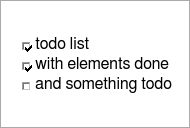Lists
Three types of lists are supported:
- ul - unordered list from array
- ol - ordered list from array
- dl - definition list from object
- check - list with check boxes
All this lists allow for alphanumeric sorting. Give true as second parameter or
false for reverse sorting but keep in mind that this is only working correctly
in straight lists (not sublists).
Also an additional width parameter for the markdown display width may be given as
third paramter.
Unordered List
This will create a list with bullets.
CoffeeScript Code report.ul [
'one'
'two'
"and this is a long text because i can't only write numbers
down here to show the proper use of the lists also with long text lines" 'last\ntwo lines'
report.hr()
report.ul [
'one'
'two'
['subline', 'and more']
'three'
]In the markdown the same list is defined as:
Markdown Document - one
- two
- and this is a long text because i can't only write numbers down here to show
the proper use of the lists also with long text lines
- last\
two lines
---
- one
- two
- and more
- subline
- threeAlternatively *, + or - may also be used as list symbols, also in mixed
format.
Markdown Document + Create a list by starting a line with `+`, `-`, or `*`
+ Sub-lists are made by indenting 2 spaces:
- Marker character change forces new list start:
* Ac tristique libero volutpat at
+ Facilisis in pretium nisl aliquet
- Nulla volutpat aliquam velit
+ Very easy!And renders as HTML:
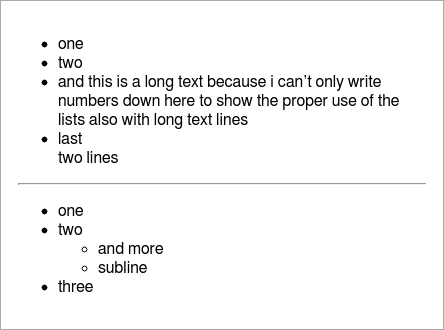
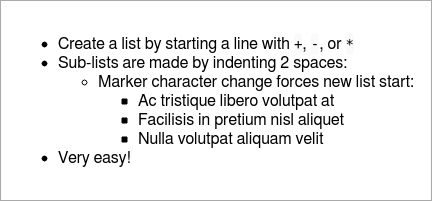
Ordered List
This will create a numbered list.
CoffeeScript Code report.ol [
'one'
'two'
"and this is a long text because i can't only write numbers
down here to show the proper use of the lists also with long text lines" 'last\ntwo lines'
report.hr()
report.ol [
'one'
'two'
['subline', 'and more']
'three'
]In the markdown the same list is defined as:
Markdown Document 1. one
2. two
3. and this is a long text because i can't only write numbers down here to show
the proper use of the lists also with long text lines
4. last\
two lines
---
1. one
2. two
1. and more
2. subline
3. threeIt doesn’t matter if you give the same number multiple times, only the first number’s value is used to start numbering. To start at a specific number start with it:
Markdown Document 1. You can use sequential numbers...
1. ...or keep all the numbers as `1.`
Start numbering with offset:
57. foo
1. barAnd renders as HTML:
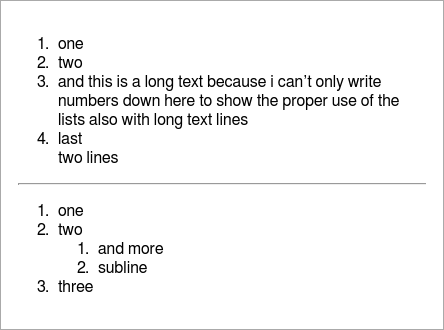
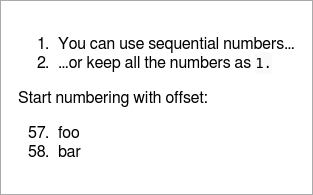
Definition List
This will display some phrases as list entries with their contents.
CoffeeScript Code report.dl
html: 'Markup language for internet pages'
css: 'Style language to bring the layout into html'
, trueLike seen in the example the sorting may be set to true.
In the markdown the same list is defined as:
Markdown Document css: Style language to bring the layout into htmlhtml: Markup language for internet pages
In the markdown you may also use:
Markdown Document Term 1
: Definition 1
with lazy continuation.
Term 2 with *inline markup*
: Definition 2
Second paragraph of definition 2.
Compact style:
Term 1
~ Definition 1
Term 2
~ Definition 2a
~ Definition 2bAnd renders as HTML:
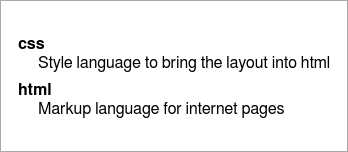
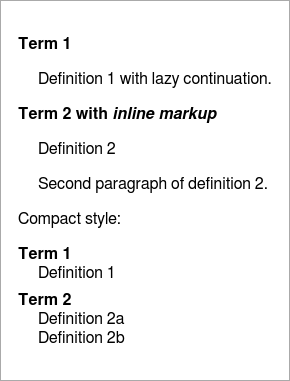
Check Lists
A check list in which each row maybe done or not.
CoffeeScript Code report.check
'todo list': true
'with elements done': true
'and something todo': falseThe values in the given map defines if they are done or not.
As markdown this is written as:
Markdown Document [x] todo list[x] with elements done[ ] and something todo
And renders as HTML and console output:
